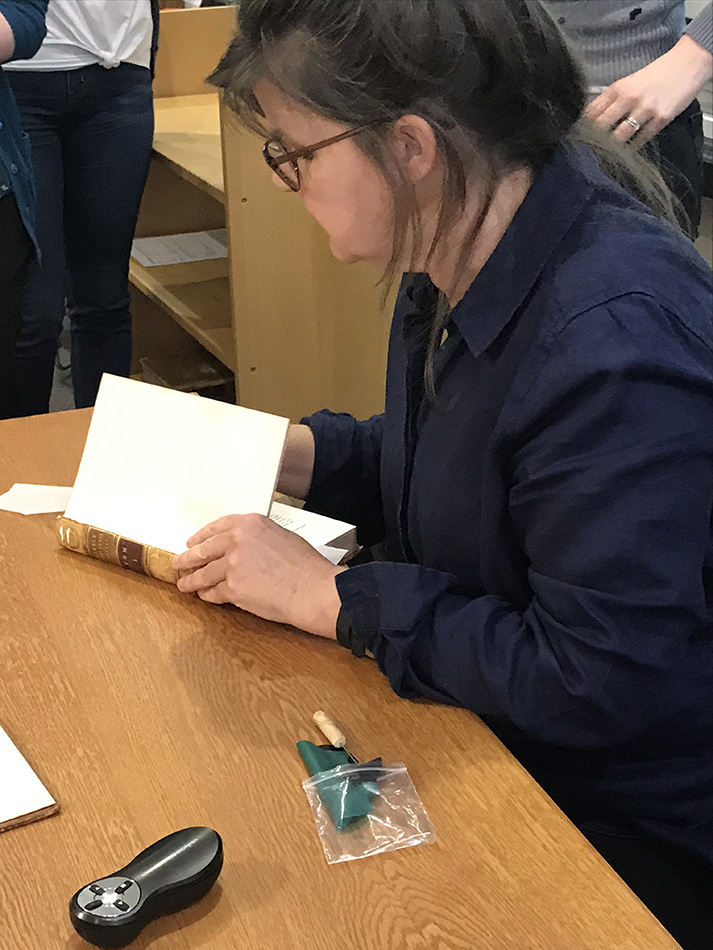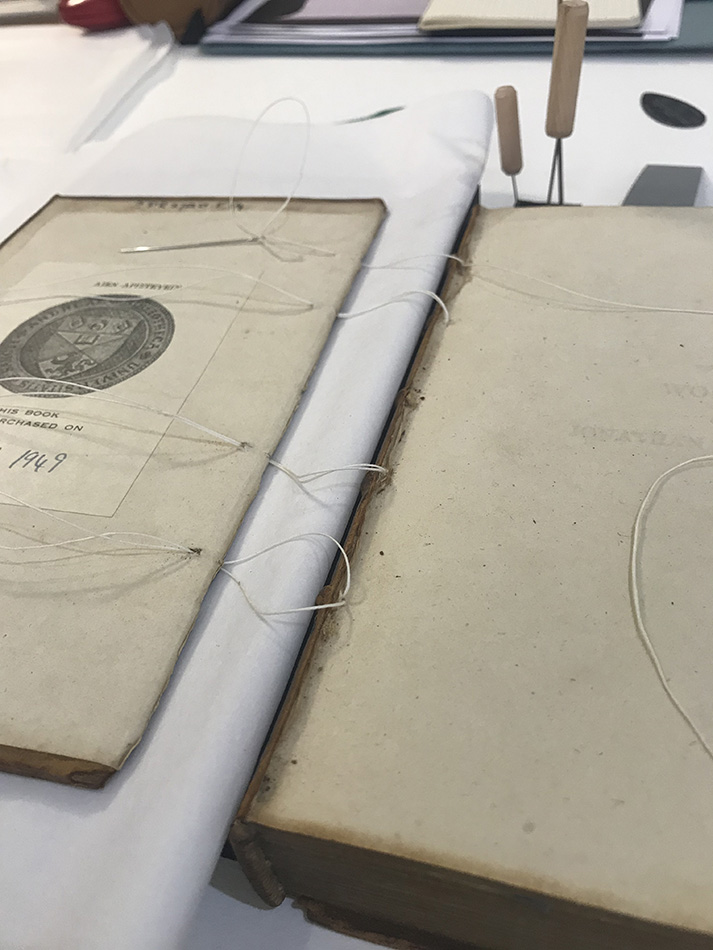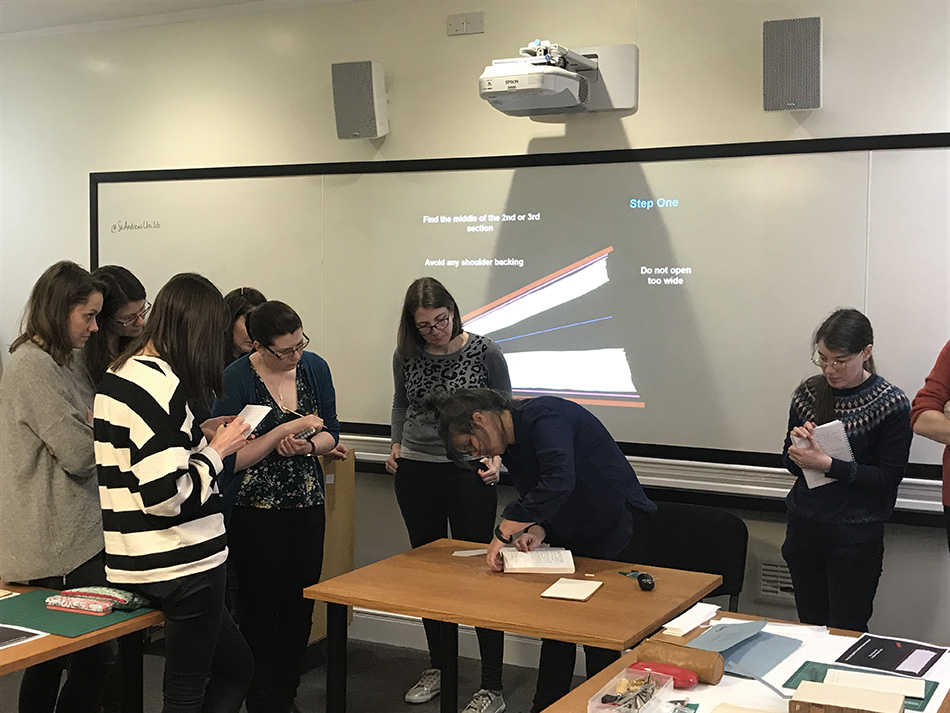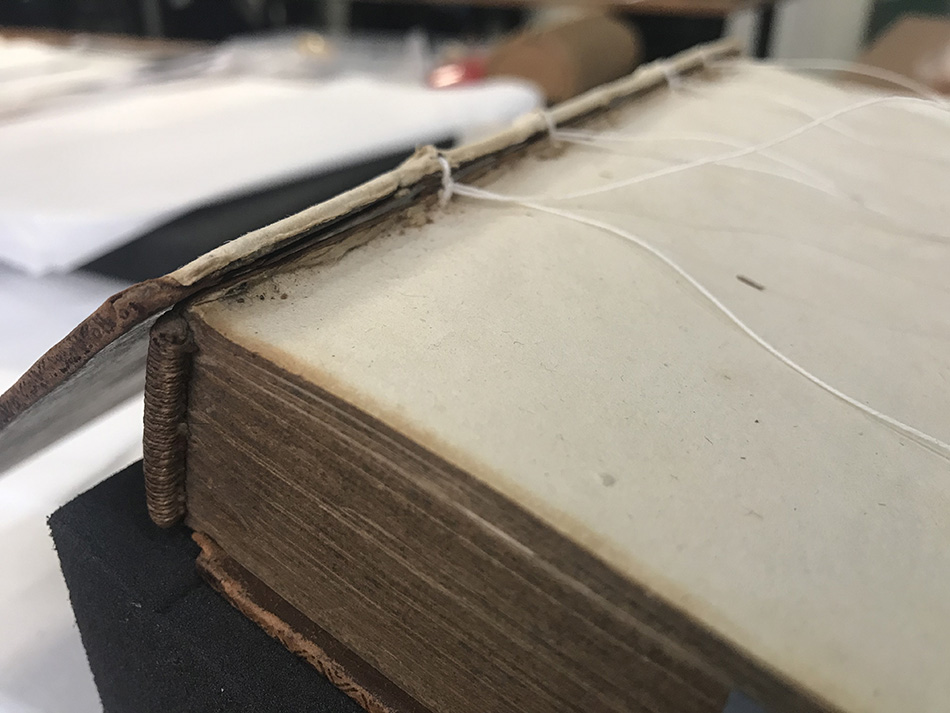Get your boards on: A new method of board re-attachment for tight-back bindings
A tour around the rare books in the Library’s Special Collections reveals many volumes with bands of cotton tape tied around them. The white tying tape serves to warn staff that the ‘tied’ volume is physically damaged in some way and therefore requires extra careful handling, if it is stable enough to be handled at all.
Physical damage to historic bindings typically occurs mostly from handling and use over time. It includes head caps and the endbands which they serve to protect literally being pulled off, spines cracking along popular openings in the textblock and boards which are loose or completely detached. The danger with all these types of physical damage is that the mechanical function of the bound volume is compromised, increasing the risk of further damage and loss with future handling. Solutions such as ‘tying’ or boxing volumes do work to keep loose elements together but the volumes remain unstable and there is a danger that loose parts can become disassociated from their originals. The losses can range from pieces of binding leather to loose pages,sections, boards or fly leaves, all of which may carry important information about the production, history and provenance of the volume.
With extensive holdings under its care, many of the preventive conservation measures which Special Collections take aim to extend the life of the collection as a whole. So we define and monitor the temperature and relative humidity conditions, undertake basic housekeeping and cleaning in the stores and monitor pest activity in areas where the collections are kept and used. Sometimes it is also necessary to care for individual items and to address physical damage with interventive conservation.
In this context, Special Collections hosted a practical workshop for qualified book and paper conservators on Tuesday 19th March 2019. The workshop was led by accredited book conservator Emma Fraser, and presented her method of reattaching loose or fully detached boards on tight-back bindings. The training event was organised and held in association with the Scottish group of the Institute of Conservation, Icon, the professional body representing conservators in the UK.
Delegates included conservators from Edinburgh and Aberdeen Universities, the National Library of Scotland, the National Trust for Scotland, the UK Parliamentary Archive and several freelancers in private practice.
The workshop started with a review of current and historic techniques for board reattachment, ranging from repairs which rely on an adhesive and a repair material to the more interventive ‘joint-tacketing’ which uses thread for the re-attachment. Although well established, there are disadvantages to these techniques. They can not be strong enough where the re-attachment is only by means of Japanese kozo paper (mulberry paper) and wheat starch paste. They can also require access to the spine, for example for spine linings, which may not always be easily accessible, and they are unnecessarily interventive techniques.
It was assumed that delegates had a good knowledge of book anatomy, of typical damage to books and had practical experience of interventive treatments but the presentations were also accessible for those with less experience. Discussion of delegates’ preferred repair methods and experience was encouraged and enhanced the session.

Emma presented her board attachment method in theory with a series of slides from previous projects, and also with diagrams for clarification. Delegates were given the chance to examine a leather-bound volume repaired in Emma’s studio using her technique. It was very helpful to see a physical example which could be tested for strength and movement.
The practical sessions followed the theory. Each delegate worked on a tight-back binding with a detached board that was either their own or selected from St Andrews University Library’s Special Collections. Emma led the group through her method step-by-step, while each delegate worked on her own volume. The timing of the workshop was well planned and everyone managed to reattach their boards at about the same time. Emma filled the session with practical tips and pointers, and went on to talk about how the attachment technique can be finished off with a very light-weight toned outer joint repair. The repair is cosmetic rather than structural but finishes off a treated volume.
 Emma’s elegant solution for board reattachment feels like a development and refinement of ‘joint-tacketing’. It combines the strength of thread attachment but avoids the very interventive need to drill into the shoulder of the book. Unlike tacketing, Emma’s method does not restrict the opening of the volume and it avoids the need to lift original leather covering material which can be fragile and readily damaged. Personally I like Emma’s solution for keeping text block and boards together without the need to create fundamental changes to the original binding structure. I was particularly interested to learn about how Emma has developed and changed her own method, especially her use of a very light-weight Japanese paper for her outer joint repairs.
Emma’s elegant solution for board reattachment feels like a development and refinement of ‘joint-tacketing’. It combines the strength of thread attachment but avoids the very interventive need to drill into the shoulder of the book. Unlike tacketing, Emma’s method does not restrict the opening of the volume and it avoids the need to lift original leather covering material which can be fragile and readily damaged. Personally I like Emma’s solution for keeping text block and boards together without the need to create fundamental changes to the original binding structure. I was particularly interested to learn about how Emma has developed and changed her own method, especially her use of a very light-weight Japanese paper for her outer joint repairs.
I am constantly reminded, through my commissioning of interventive conservation from external private conservators, of the importance of recording the methods and materials used in all treatments, right down to the weight of the repair paper! As Emma’s method becomes more widely known and well-established, perhaps it will simply become known as the ‘Fraser re-attachment’ in documentation reports.
Special thanks to Gabriel Sewell and John MacColl for their permission to host the event and for generously providing the catering, and to Elizabeth Henderson for permitting collection items to be used in the workshop – we now have some more beautifully repaired books!
Erica Kotze ACR
Preventive Conservator
Images courtesy of Mary Garner.

